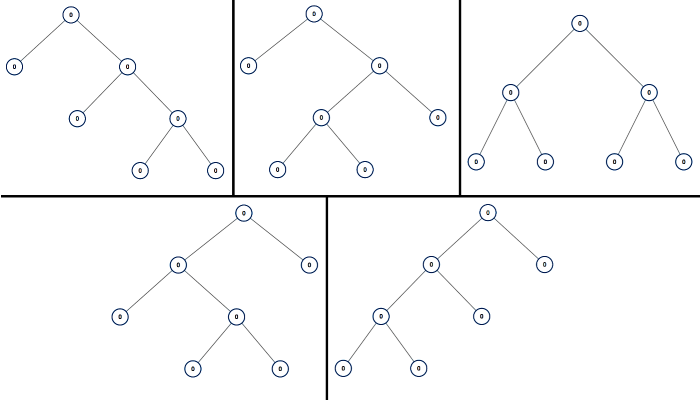All Possible Full Binary Trees
第18天。
今天的题目是 All Possible Full Binary Trees :
A full binary tree is a binary tree where each node has exactly 0 or 2 children.
Return a list of all possible full binary trees with N nodes. Each element of the answer is the root node of one possible tree.
Each node of each tree in the answer must have node.val = 0.
You may return the final list of trees in any order.
Example 1:
1 | Input: 7 |

Note:
1 <= N <= 20
这道题就是一个穷举的问题,我们知道完全二叉树的节点个数一定是奇数,所以可以先把N为偶数的输入先处理掉,然后就是怎么穷举的问题了。显然,一个完全二叉树的子树一定也是完全二叉树,所以我们可以以1,3,5...,N-2的方式穷举出出左子树中节点的个数i,已知左子树节点个数,那么右子树节点的个数就为N-i-1,我们先把左子树和右子树的可能都算出来,然后就再计算它们两两组合的所有可能即可得到所有节点个数为N的完全二叉树的情况。总的来说,就是一个大问题化简成小问题的思路。所以我们可以写出如下代码:
1 | TreeNode *copyTree(TreeNode *root) { |
然后你会发现好像可以用一个数组来存在已经求解出来的结果,如果再一次求,我们可以直接返回了:
1 | vector<TreeNode*> &allPossibleFBT(int N, vector<vector<TreeNode*>> &cache) { |
如果熟悉动态规划的话,就会发现可以自顶向下的求解方式转成自底向上的求解方式,这里我们就不需要用递归去求解:
1 | vector<TreeNode*> allPossibleFBT(int N) { |
最后,这份代码在LeetCode大概只能超过50%,如果要进一步,只有把copyTree去掉,直接赋值。这种方式是可行的,但是感觉只是在刷题时的一种技巧而已:
1 | vector<TreeNode*> allPossibleFBT(int N) { |